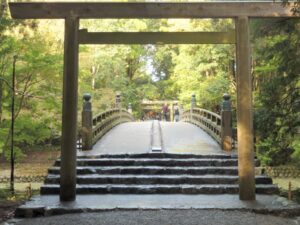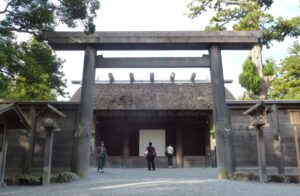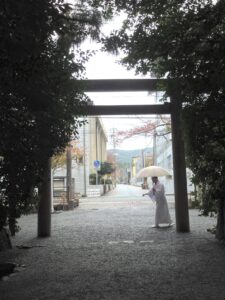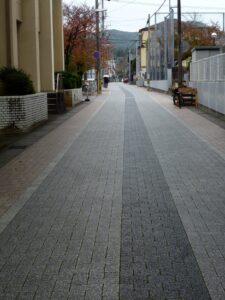John Billingsley walks a haunted and fated ‘spirit road’ in Japan’s spiritual heart

Ujibashi: The bridge and torii mark the entrance to the sacred precincto Amaterasu at Ise Naikū shrine. It is aligned on the winter solstice sunrise

Visitors purify themselves in the isuzu River at Naikū
The Grand Shrine of Japan’s Shinto belief system is located at Ise, in Mie Prefecture, and consists of two sacred precincts a few miles apart. The greater of the two is Naikū, or the Inner Shrine, officially known as Kōtai Jingū, and lies in an area of sacred mountains outside the town. It is sacred to Amaterasu, the Sun Goddess, and the premier deity of the pantheon. In Ise itself is Gegū (aka Gekū), or Toyouke Daijingū – the Great Shrine of Toyouke no Ōmikami, the goddess of agriculture. These two goddesses are considered to look after the safety, sustainability and fertility of the Japanese archipelago, and are much visited both for prayer and for tourism – especially as part of Japan’s new ‘power spot’ brand of tourism that has taken root amongst younger people. As a result, Ise today is very much busier than when I first visited it in the 1980s.

Ise Gegū (Outer Shrine)
However, just up a side-street from Gegū is another important shrine that receives very few visitors – the shrine, Takakawara Jinja, is naturally much smaller than the Grand Shrines. It is better known as Tsukiyomi-no-miya, the shrine of the Tsukiyomi, the Moon God.

Shrine priest at the entrance torii of Tsukiyomi-n-miya, looking along Kamiji-dori
 Kamiji-dori, with central path for spirit passage
Kamiji-dori, with central path for spirit passage
To label its approach road a side-street is actually pretty disrespectful. Its name is Koji Kamiji, or more often Kamiji Dōri – the element kami in the name tells you it has a link with the divine realms. There were certain taboos observed in this street – people avoided walking down the centre of it, and houses that had outside toilets would not set their doors to open out on to the street. Kamiji Dōri is wider than most Japanese streets, and almost dead straight – a slight kink is introduced to deter evil spirits, or deflect the ‘hidden arrow’ frowned upon in feng-shui (fu-sui in Japanese); but no other impediment is placed to hinder free and direct passage for the deity to proceed between his shrine and Gegū, which he did every night. A stone wall at the entrance to Tsukiyomi-no-miya shimmers, and in the darkness turns into a white horse, standing facing the shrine, awaiting its divine rider, and then they set off down the street towards Gegū. People naturally didn’t want to get in the way of this awe-full spectral progress, so avoided the street at night, or if they had to walk on it, kept to the side of the road – even in today’s street paving, the centre is marked off in a separate pattern.
 Tsukiyomi-no-miya
Tsukiyomi-no-miya
Research by Paul Devereux has amply shown a worldwide pattern of pathways held to be routes of spiritual passage, from the souls of the dead to the travels of local deities and humans considered to have a direct connection with the divine.1 The approach roads (sandō) to Shinto shrines are invariably straight, albeit with a slight kink as here, leading under and through sacred gateways (torii). A busy urban street in Kyōto runs from a river to a huge cemetery that was once an excarnation place, past a Buddhist temple credited with direct access to the Underworld via a well, and other sites bearing legends with similar liminal identity; the route is embellished by a ghost tale of a woman who gave birth in her grave.2 Straight tracks defining spiritual passage of some sort are clearly a feature of Japanese lore and history, as of elsewhere.
Notes
- See, e.g. Paul Devereux, Haunted Land (Piatkus, 2001), Fairy Paths & Spirit Roads (Vega, 2003)
- John Billingsley, ‘A death road in Kyōto’, Fortean Times 335, 2015
Published in NE163 (March 2021), p22-23